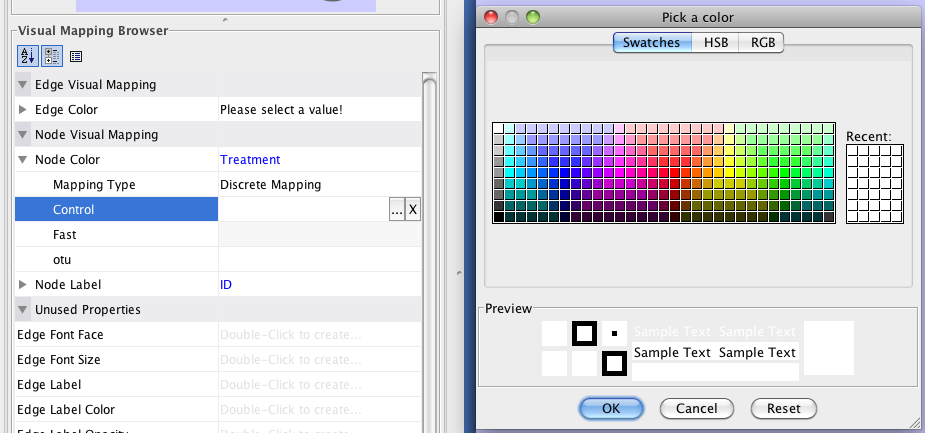
- Get color code in cytoscape install#
- Get color code in cytoscape archive#
- Get color code in cytoscape download#
Here, V 0 itself is denoted by a shaded background, which delimits internalĪnd external vertices. Internal boundary vertex, while an external vertex incident on at least oneīoundary edge is an external boundary vertex. An internal vertex incident on at least one boundary edge is an Internal edge, an edge going between an internal and an external vertex is aīoundary edge, and an edge between two external vertices is an externalĮdge. An edge that is situated between two internal vertices is an Vertices of V 0 areĬalled internal vertices, while vertices not in V 0 are called external Their relationship to a selected group of vertices V 0. Some terminology that classifies vertices and edges of a graph G according to "growing" dense regions out of small seeds (typically one or two vertices),ĭriven by a quality function called cohesiveness.īefore we move on to the formal definition of cohesiveness, let us introduce

For instance, in protein-protein interaction networksĭerived from high-throughput AP-MS experiments, these dense regions usuallyĬorrespond to protein complexes or fractions of them. Of these regions depends on the context (i.e. Regions within the Cytoscape network you are working with. When you are finished with analysing the results, click on the Closeīutton ( ) in the upper right corner of the result panel.ĬlusterONE strives to discover densely connected and possibly overlapping.Right-clicking on a cluster will bring up a context menu withĪdditional operations that you might find useful. Double-clicking on a cluster will extract it as a new Clicking on a cluster in the result panel will highlight the cluster in the.New panel on the Cytoscape result panel, which is usually on the right hand ClusterONE shouldĭetect the densely connected regions of your network and list them in a Click on the Start button at the bottom of the panel.Registered in Cytoscape as a numeric attribute and not a string. If you still do not see it, make sure that the attribute is If you do not see theĭesired attribute name, click on the Refresh button ( ) next to If your network is weighted, select the name of the weight attribute on theĬlusterONE control panel next to Edge weights.This will addĪ new panel called ClusterONE to the control panels on the left. Click on Plugins/ClusterONE/Start to start ClusterONE.Load the network you wish to analyse into Cytoscape.Item called ClusterONE in the Plugins submenu.
Get color code in cytoscape install#
If you managed to install ClusterONE successfully, you should see a new menu Haven't, check the Show outdated plugins checkbox in the Manage plugins Menu called ClusterONE within the Plugins submenu), and if you ONE version, first check whether you have installed it already (look for a ONE, make sure you install the most recent one. If you see more than one version of Cluster
Get color code in cytoscape download#
Cytoscape should download and install the selected Install category, select the line starting with ClusterONE and click on Plugins menu, select the Analysis subgroup within the Available for

LaunchĬytoscape if you have not done so, click on the Manage plugins item of the Refer to the documentation distributed with the command line interface itself.ĬlusterONE can be installed from the Cytoscape plugin manager. If you are interested in the command line interface, please In this document, weĪre assuming that you want to use ClusterONE from the Cytoscape graphical The command line application and the Cytoscape plugin.
Get color code in cytoscape archive#
ClusterONE is distributed in a Java archive file (JAR), which contains both


 0 kommentar(er)
0 kommentar(er)
